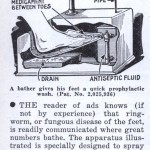[from my GeekDad post]
Lest we take the modern GeekDad for granted, I submit for your attention this comic strip from 95 years ago regarding the exploits of a ‘lectric-obsessed child and his less-than-supportive father. (Click through for the rest of the comic.)
This was before the first personal computer, before the Nerds took their Revenge, before Superman first flew. There was no Bill Gates to emulate, no William Yuan to envy, no Starfleet Academy to aspire to. Words like internet, blog, and cosplay had yet to be coined, and there were no words spoken in Klingon, Elvish, or Huttese at all. There was no Xbox. There was no Wii.
So in this context, perhaps we shouldn’t be too hard on young Henery’s father. The white-fringed, mustachioed man doesn’t realize he’s trying to hold back the tsunami of geek inevitability with a wooden paddle. He might have lived to see his son’s “fool inventions” land ships on the Moon and recanted, apologizing for putting a pack of cigars and a good night’s before his son’s passion for creating.
Even if he didn’t, he can serve as an example to us, and we can feel good to be GeekDads.
(image from Modern Mechanix, a source of much old-timey awesomeness)


